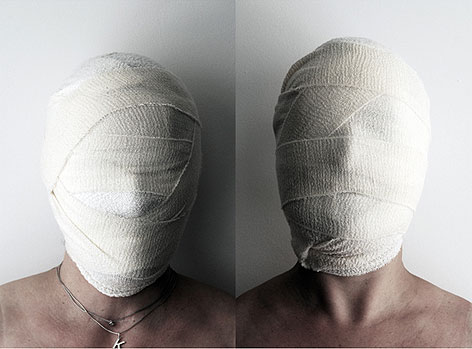Exhibition starts 25th June 2010
15 Aug 2013

MA Digital Media Arts final year show 2010, features; perspex pyramids that reflect the current economic climate, eco sensitive plants that respond to human interference…the surreal world of Leonora Carrington, a bathroom cabinet with a dark secret to tell... an interactive reminder about the meaning of life… a 3D virtual image experience, a fusion dating booth, a geo-located open photography exhibition with crowd-sourced curation, intimate secrets whispered on the outskirts of the conscious mind, mythical sirens of the sea...a voyeuristic peer into the mundanity of an animated sub-world… site-specific sonic spaces, come and find the acoustic railings in the university gardens.
Yet again this year's graduates push the boundaries of contemporary arts practice, placing Brighton’s MA Digital Media Arts at the forefront of tomorrow’s media arts economy.
MA Digital Media Arts is delivered at the University of Brighton Faculty of Arts and at the Lighthouse Arts Agency, Brighton. Students explore a broad range of creative digital practices, and access the most up-to-date developments in digital media arts.
Situated within the Faculty's School of Arts and Media, student practice areas include public art and participatory work, the internet, interactive web-casting, digital film and installations. The course has been developed in the context of Brighton’s status as one of Europe’s main centres of the media economy. It provides the production skills, and develops the individual approaches and bodies of work, required for success in this fast-moving, competitive industry.
Private View: 25th June 2010. 17.30 – 8.30pm
University of Brighton
Grand Parade, Brighton, BN2 0JY
United Kingdom - 01273 600 900
Course Director Sue Gollifer
For Further Information and digital images please contact:
Jane McGrath - 07960994753 - justjanie@btopenworld.com
www.madma2010.org.uk
Ben Crossman brings a range of influences from his multi-disciplinary background (medical illustration, design, video, music) into his studio work. Drawing upon interests in semiotics, power structures and social/economic systems, Ben’s 2010 degree show work focuses on raising questions about the nature of banking, the state of our monetary economy, and the increasingly controversial relationship between money and art.
Hailing from the North West of England, Ben currently lives and works in Brighton, UK.
I’m interested in perception of spaces and how sounds/noises we hear can impact upon our understanding and awareness of the places we live. Limbus is an interactive installation based on audio listening and field recordings taken from the everyday. The project focus on the concept of how people can explore cities in an alternative way and address ‘listening to’ rather than ‘hearing’. Limbus presents an acoustic railing and explores concepts of curiosity, sociality and proximity. The audience is invited to a more conscious experience of the sonic space around us. My aim is to create an active relationship between public places, sound architecture surroundings and our liquid bodies.
James Beckett's earlier work started with photography and stop frame animation, however more recent work has spanned into interactive spaces. His most recent work Misanthropy questions our relationship with nature, and natural environments. It explores humanity's relationship with the natural resources we depend so heavily upon, and aims to show the delicate balance between the possibility of a symbiotic relationship with nature, versus a detrimental one. His work also raises issues of Biotechnology, and human interference with nature in a far more creative, scientific way.
Montague Terrace is a flash based video installation based on my comic series of the same name where we peer voyeuristically into the hidden lives of the forgotten residents of a large, residential block, somewhere in South London. Unaware of our Hitchcockian gaze, the mundane merges with the super-natural as we tap into our naturalistic urge to be nosey bastards.
I’m interested in visual narratives and for this work, I wanted to explore, expand and experiment with the characters lives away from the printed page, incorporating the virtual dimensions of soundtrack and animation to suggest mood and melancholy.
“I try to empty my self of images that have made me blind.” Leonora Carrington
Interview with Marina Warner, 1987 (The House of Fear, notes from down below. 1989)
House of Fear explores Feminist themes of power and vulnerability through Magical Realism, with a referential nod to the work of both Yoko Ono and Surrealist Leonora Carrington. Combining traditional hand-crafted sculptural forms with electronics and programming, domestic objects come alive; hand- coiled pots crafted in an eggshell mosaic defiantly laugh as they are pushed around and The Gorgons Table emits a series of male monologues for women to consume. In The House of Fear a mirror provides protection against violence – offering its users a magical horse’s head boxing guard…while the horse’s hooves give flight to a chair across the room…
Whiteread presents a body of work that takes a surprising turn away from her work as an architectural projectionist. Subverting her usual scale and methods of encounter she chooses to look up close and personal as she now explores the inside rather than the out.
This work moves away from the community voice and explores the more personal and intimate voices found inside memory; of her self, her parents and her childhood home and an intricate family tree is recreated through the objects she chooses to animate with small scale projection and sound; a dolls house explores sibling rivalry while mum and dad sit side by side as bathroom cabinets – each with their own dark secrets to tell…